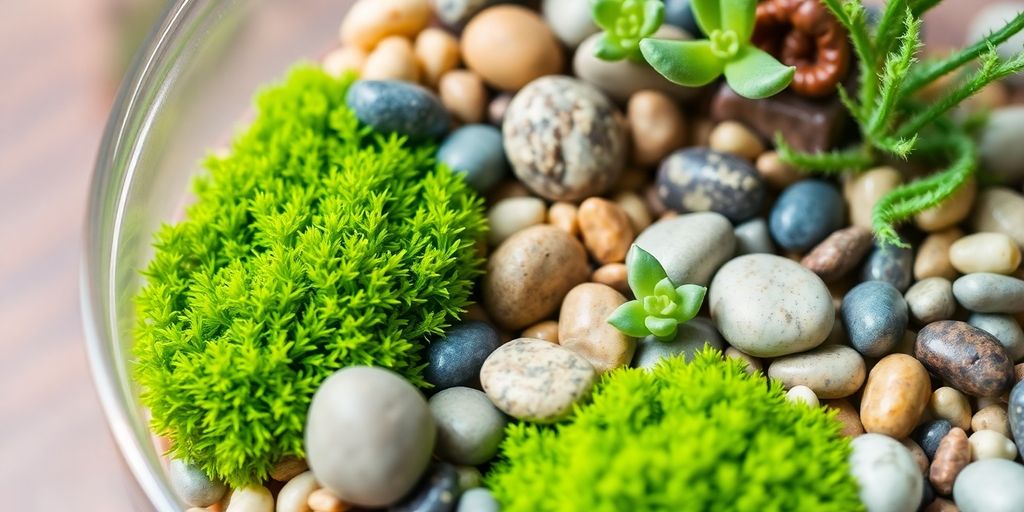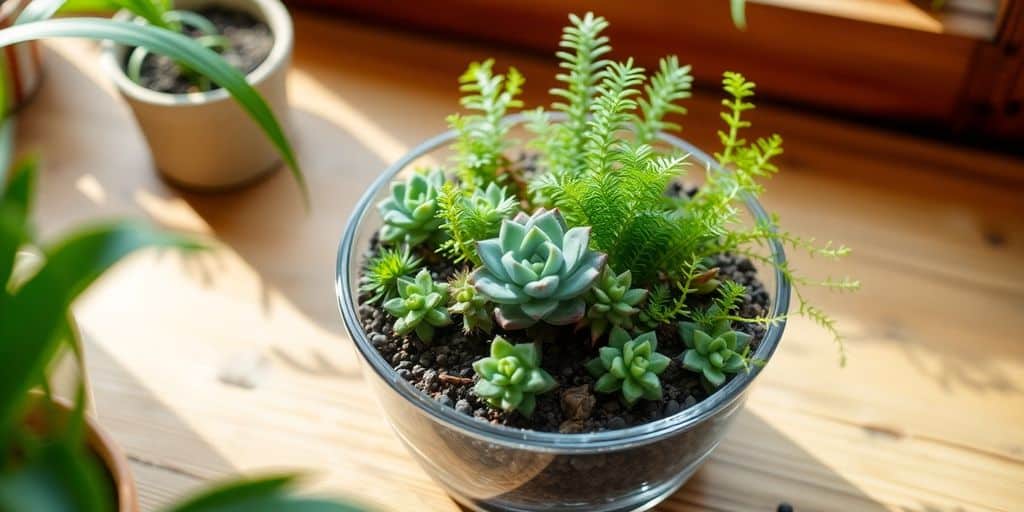How to create a terrarium at home easy and affordable is a fun project for anyone looking to bring nature indoors. Terrariums are stylish, compact, and surprisingly simple to make. They add a touch of green to any room without taking up much space.
Perfect for beginners, terrariums require minimal materials and just a bit of creativity. You don’t need a green thumb or a big budget to get started. With the right steps, you can build your own mini ecosystem in no time.
These glass gardens not only look beautiful, but they also create a calming vibe in your home. Whether on a desk, shelf, or windowsill, they’re both decorative and low-maintenance. It’s a small project with a big impact.
Curious about how to begin? This guide will walk you through each step to help you create your own terrarium—easily and affordably. Let’s bring a little nature into your space.
Key takeaways
- Choose a clear container that fits your style and space.
- Layer your terrarium starting with gravel, followed by charcoal, soil, and then plants.
- Pick low-maintenance plants to make caring for your terrarium easier.
Choosing the right container for your terrarium
Okay, so picking the right container is, like, the first big step. It’s kinda like choosing the right house for your plants, ya know? You want something that looks good, but also works well for what you’re trying to do.
I’ve seen people use everything from old fish tanks to fancy glass jars, so don’t feel like you need to break the bank here.
Exploring different types of glass containers
Seriously, the options are endless. You got your basic glass bowls, which are cheap and easy to find. Then there are mason jars – super trendy and give off that whole rustic vibe. I even saw someone use an old brandy snifter once, which was pretty cool.
The main thing is to make sure it’s clear so you can actually see your little plant world. Here’s a quick rundown:
- Open Containers: Great for plants that don’t like a lot of moisture, like succulents and cacti. Think bowls or open jars.
- Closed Containers: These are better for tropical plants that need humidity. Jars with lids or terrarium-specific containers work well.
- Repurposed Containers: Get creative! Old aquariums, cookie jars, even pickle jars can work if they’re clean.
Tips for selecting the perfect size
Size matters, believe me. You don’t want a container that’s so small your plants are cramped, but you also don’t want one so big it looks empty. I usually go for something that’s at least 6 inches deep, just to give the roots some room to spread out.
And make sure the opening is wide enough so you can actually get your hand in there to plant stuff! Trust me, you’ll thank me later. I’ve made that mistake before, and it’s not fun trying to maneuver plants into a tiny opening.
Also, consider the mature size of the plants you plan to use. You don’t want them outgrowing their home in a few months!
Essential materials for building a terrarium easy and affordable

Okay, so you’ve got your container picked out – awesome! Now, let’s talk about what you’ll need to actually build the thing. I remember when I first started, I thought I could just throw some dirt and plants in a jar and call it a day. Boy, was I wrong! There’s a bit more to it, but don’t worry, it’s still super easy.
Layering your terrarium components
Think of building a terrarium like making a layered dip – each layer has a purpose! Here’s the lowdown on what goes where:
- Gravel or Pebbles: This is your drainage layer. It sits at the bottom and prevents the soil from getting waterlogged. Nobody likes soggy roots!
- Activated Charcoal: This stuff is like a Brita filter for your terrarium. It helps to keep things fresh by filtering out toxins and odors. You can usually find it at pet stores (it’s used in aquariums) or garden centers.
- Mesh or Landscape Fabric: This layer keeps the soil from mixing with the gravel. Trust me, you don’t want muddy gravel.
- Potting Soil: Use a sterile, well-draining mix. Regular garden soil is usually too heavy and can introduce unwanted critters.
- Plants: Obviously! Choose plants that are suited for a terrarium environment (more on that later).
- Moss (Optional): This adds a nice decorative touch and helps to retain moisture. Plus, it just looks cool.
Affordable options for terrarium supplies
Building a terrarium doesn’t have to break the bank. Here are some ways to save some dough:
- Gravel: Instead of buying aquarium gravel, use small pebbles from your yard (just make sure to wash them first!).
- Activated Charcoal: You can skip this layer if you’re on a tight budget, but I really recommend it for long-term terrarium health.
- Potting Soil: Buy a small bag of potting mix instead of a huge one. You really don’t need that much.
- Moss: Collect moss from your yard (if you have it) or ask a friend who does. Just make sure it’s legal to harvest moss in your area.
- Decorative Elements: Use things you already have around the house, like interesting rocks, shells, or small figurines. Get creative! I once used a tiny plastic dinosaur in a terrarium, and it was a total hit. It’s all about having fun with it, ya know?
Selecting plants for your terrarium

Best low-maintenance plants for beginners
Okay, so you’ve got your container and your layers all set. Now comes the fun part: picking out the plants! This is where you can really let your creativity shine. But, if you’re anything like me when I started, you might be a little overwhelmed. Don’t sweat it! There are tons of plants that are super easy to care for and perfect for beginners.
- Small ferns: These are great for adding a touch of green and they love humidity, which is perfect for a closed terrarium. I’ve had good luck with maidenhair ferns, but there are tons of varieties to choose from.
- Moss: Can’t go wrong with moss! It’s easy to care for, looks great, and helps retain moisture in your terrarium.
- Nerve plant (Fittonia): These guys are drama queens – they’ll wilt if they’re thirsty, letting you know it’s time to water. Plus, they come in a bunch of cool colors and patterns.
- Polka Dot Plant (Hypoestes phyllostachya): Adds a pop of color with its spotted leaves. They’re relatively low-maintenance and enjoy the humid environment of a terrarium.
Creating a balanced plant arrangement
Alright, so you’ve got your plants picked out. Now, how do you arrange them so your terrarium looks like a tiny, thriving ecosystem and not just a random collection of greenery? Here’s what I usually do:
- Consider the size: You want plants that will stay relatively small, so they don’t outgrow your terrarium too quickly. I made that mistake once and had to completely redo my setup!
- Think about height: Place taller plants towards the back and shorter ones in the front, so you can see everything. It creates a nice sense of depth.
- Mix textures and colors: Combine plants with different leaf shapes, sizes, and colors to add visual interest. A little variety goes a long way.
- Don’t overcrowd: Give your plants some room to breathe. Overcrowding can lead to problems with air circulation and moisture, which can cause your plants to get sick. Less is more, trust me on this one.
Final thoughts on how to create a terrarium at home easy and affordable
Creating a terrarium at home is not just a fun project; it’s a way to bring a bit of nature indoors. With just a few simple materials and some low-maintenance plants, you can craft a beautiful mini-ecosystem that brightens up your space.
Remember, the key is to layer your materials correctly and choose plants that thrive in humidity. Don’t stress if it doesn’t look perfect at first—every terrarium has its own charm. So, gather your supplies, get a little creative, and enjoy the process. You’ll be amazed at how rewarding it is to watch your little garden grow!
Frequently asked questions
What type of container is best for a terrarium?
You can use any clear glass container, like a jar or a vase. Just make sure it has a wide opening so you can easily reach inside to arrange your plants.
How much does it cost to make a terrarium?
You can create a terrarium for around $20 to $100, depending on the materials and plants you choose.
What plants are good for beginners in a terrarium?
Some easy plants for beginners include ferns, moss, and small tropical plants. They don’t need much care and grow well in a humid environment.
